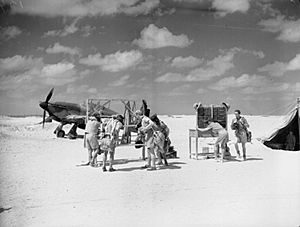Owen Tracey facts for kids
Quick facts for kids
Owen Tracey
|
|
|---|---|
| Born | 15 March 1915 Dunedin, New Zealand |
| Died | 8 December 1941 (aged 26) near El Adem, Libya |
| Allegiance | New Zealand |
| Service/ |
Royal Air Force |
| Years of service | 1939–1941 † |
| Rank | Flight Lieutenant |
| Unit | No. 274 Squadron No. 79 Squadron |
| Battles/wars | Second World War |
| Awards | Distinguished Flying Cross |
Owen Vincent Tracey DFC (born March 15, 1915 – died December 8, 1941) was a brave New Zealand fighter pilot. He was known as a flying ace because he shot down at least six enemy planes. He flew for the Royal Air Force (RAF) during the Second World War.
Owen Tracey was born in Dunedin, New Zealand. He joined the RAF in early 1939. After training, he joined No. 79 Squadron in July 1940. He flew many missions during the Battle of Britain, where he destroyed several German aircraft. In April 1941, he moved to the Middle East. There, he flew with No. 274 Squadron. He fought in the Battle of Crete and Operation Crusader in Libya. Owen Tracey was killed when his plane was shot down by Italian fighters.
Contents
Early Life and Learning to Fly
Owen Vincent Tracey was born in Dunedin, New Zealand, on March 15, 1915. His parents were Owen and Margaret Tracey. He went to school in Auckland and Oamaru. After school, he worked as a storeman in Dunedin.
Owen loved aviation and learned to fly at the Otago Aero Club. In 1937, he earned his pilot's license. He tried to join the Royal Air Force (RAF) several times. At first, he was told there were no spots or his school grades were not high enough. He studied harder and finally got accepted in 1938.
He left New Zealand in mid-1939 and arrived in England on August 1. Soon after, he started his flight training. He learned to fly planes like the de Havilland Tiger Moth.
Fighting in the Second World War
The Second World War began while Owen Tracey was still training. He earned his pilot's wings and became an acting pilot officer in October 1939. He continued his training, learning to fly the Hawker Hurricane fighter plane.
The Battle of Britain
On July 6, 1940, Owen Tracey joined No. 79 Squadron. His squadron flew Hurricane fighters. They were based at RAF Biggin Hill at first. Later, they moved to RAF Acklington to help defend the Midlands.
- First Victory: On August 15, Owen Tracey shot down a German Heinkel He 111 bomber. This happened during a large German air raid heading towards Newcastle.
- Fighting Over London: The squadron returned to Biggin Hill on August 26. They soon faced heavy fighting over London. On August 28, Owen likely destroyed another He 111. He also damaged a Messerschmitt Bf 109 fighter. His own Hurricane was damaged, and he had to land. He tried to take off again, but his plane was hit by bomb pieces from a nearby explosion. He was not hurt, but other RAF people died.
- More Victories: Two days later, he destroyed another He 111. On August 31, he shot down a Dornier Do 17 bomber over Dungeness.
- Rest and Patrols: On September 5, Biggin Hill was attacked again. Owen likely destroyed another Do 17. A few days later, his squadron moved to RAF Pembrey for a rest. From there, they flew patrols and intercepted bombers. On September 21, Owen likely destroyed another Do 17. He was confirmed as a pilot officer in November.
Missions in the Middle East
In early 1941, Owen Tracey was sent overseas. In March, he joined No. 274 Squadron in Egypt. This squadron had been fighting in Libya. Owen was promoted to flying officer the next month.
- Battle of Crete: During the Battle of Crete, No. 274 Squadron supported Allied forces. They flew patrols and attacked German troops on the island. On May 26, Owen destroyed a Junkers Ju 52 transport plane. A German Bf 109 then chased him. Owen dived, and the German plane crashed into the sea. Owen was given credit for shooting down this Bf 109. Three days later, he shot down a Junkers Ju 88 bomber. This happened while he was protecting Royal Navy ships. These ships were helping Allied forces leave Crete.
- Western Desert Operations: The next month, No. 274 Squadron returned to operations over the Western Desert. In late August, Owen was promoted to flight lieutenant. He became one of the squadron's flight commanders. The squadron mostly supported ground troops. They attacked Axis transports and soldiers.
- Heroic Rescue: During Operation Crusader, on December 1, a Hurricane pilot named Lieutenant Hoffe had to land in the desert. He was close to enemy troops. Owen Tracey bravely landed his own plane to pick up Hoffe. He then flew him back to base safely.
Final Mission and Legacy
On December 8, No. 274 Squadron was escorting Bristol Blenheim bombers. They were attacking enemy positions near El Adem. They met German and Italian fighters. The RAF planes were soon outnumbered. Owen Tracey was seen fighting a Macchi C.200 Italian fighter. His Hurricane was hit in the cockpit. His plane dived to the ground and caught fire. Owen Tracey was buried near his crashed aircraft.
Owen Tracey was given the Distinguished Flying Cross after he died. This award was announced in October 1942. The award mentioned his brave rescue of Lieutenant Hoffe. It also said he had destroyed six enemy aircraft.
After the war, Owen Tracey's remains were moved. He was reburied at Halfaya Sollum War Cemetery in Egypt. He had a wife, Frances, and a son. They later moved to New Zealand and lived in Dunedin, Owen's hometown.


